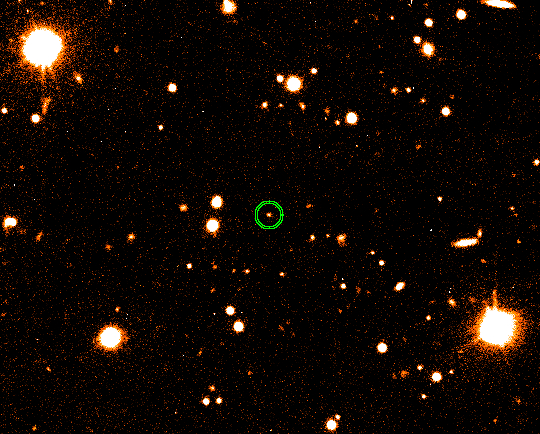Halimede (moon) on:
[Wikipedia]
[Google]
[Amazon]
Halimede , or Neptune IX, is a retrograde irregular satellite of
 Halimede, like many of the outer satellites of
Halimede, like many of the outer satellites of
 Halimede has the second most
Halimede has the second most
Matthew Holman's Neptune's page
(by Scott S. Sheppard)
MPC: Natural Satellites Ephemeris Service
* Mean orbital parameter
from JPL
{{DEFAULTSORT:Halimede (Moon) Moons of Neptune Irregular satellites 20020814 Moons with a retrograde orbit
Neptune
Neptune is the eighth planet from the Sun and the farthest known planet in the Solar System. It is the fourth-largest planet in the Solar System by diameter, the third-most-massive planet, and the densest giant planet. It is 17 time ...
. It was discovered by Matthew J. Holman
Matthew J. Holman (born 1967) is a Smithsonian astrophysicist and lecturer at Harvard University. Holman studied at MIT, where he received his bachelor's degree in mathematics in 1989 and his PhD in planetary science in 1994. He was awarded th ...
, John J. Kavelaars, Tommy Grav
This is a list of minor-planet discoverers credited by the Minor Planet Center with the discovery of one or several minor planets (such as near-Earth and main-belt asteroids, Jupiter trojans and distant objects). , the discovery of 612,011 nu ...
, Wesley C. Fraser and Dan Milisavljevic Dan Milisavljevic (born January 31, 1980) is a Canadian astronomer and assistant professor of physics and astronomy at Purdue University.
Milisavljevic received his undergraduate education at McMaster University, where he was enrolled in the presti ...
on August 14, 2002.
Name
 Halimede, like many of the outer satellites of
Halimede, like many of the outer satellites of Neptune
Neptune is the eighth planet from the Sun and the farthest known planet in the Solar System. It is the fourth-largest planet in the Solar System by diameter, the third-most-massive planet, and the densest giant planet. It is 17 time ...
, is named after one of the Nereids, the fifty daughters of Nereus
In Greek mythology, Nereus ( ; ) was the eldest son of Pontus (the Sea) and Gaia ( the Earth), with Pontus himself being a son of Gaia. Nereus and Doris became the parents of 50 daughters (the Nereids) and a son ( Nerites), with whom Nereus ...
and Doris. Before the announcement of its name on February 3, 2007 (IAUC 8802), Halimede was known by the provisional designation S/2002 N 1.
Orbit
eccentric
Eccentricity or eccentric may refer to:
* Eccentricity (behavior), odd behavior on the part of a person, as opposed to being "normal"
Mathematics, science and technology Mathematics
* Off- center, in geometry
* Eccentricity (graph theory) of a ...
and third most inclined
Incline, inclined, inclining, or inclination may refer to:
*Grade (slope), the tilt, steepness, or angle from horizontal of a topographic feature (hillside, meadow, etc.) or constructed element (road, railway, field, etc.)
*Slope, the tilt, steepn ...
orbit around Neptune. This is illustrated on the diagram in relation to other irregular satellites of Neptune. The satellites above the horizontal axis are prograde, the satellites beneath it are retrograde. The yellow segments extend from the pericentre to the apocentre, showing the eccentricity. It is also worth mentioning that Sao
SAO or Sao may refer to:
Places
* Sao civilisation, in Middle Africa from 6th century BC to 16th century AD
* Sao, a town in Boussé Department, Burkina Faso
* Saco Transportation Center (station code SAO), a train station in Saco, Maine, U.S. ...
and Laomedeia
Laomedeia , also known as Neptune XII, is a prograde irregular satellite of Neptune. It was discovered by Matthew J. Holman, et al. on August 13, 2002. Before the announcement of its name on February 3, 2007 (IAUC 8802), it was known as S/2002 ...
are similar to Halimede but they both have prograde orbits unlike Halimede which has a retrograde orbit.
Physical characteristics
Halimede is about 62 kilometers in diameter (assuming analbedo
Albedo (; ) is the measure of the diffuse reflection of solar radiation out of the total solar radiation and measured on a scale from 0, corresponding to a black body that absorbs all incident radiation, to 1, corresponding to a body that refl ...
of 0.04) and appears neutral (grey) in the visible light
Light or visible light is electromagnetic radiation that can be perceived by the human eye. Visible light is usually defined as having wavelengths in the range of 400–700 nanometres (nm), corresponding to frequencies of 750–420 tera ...
. Given the very similar colour of the satellite to that of Nereid
In Greek mythology, the Nereids or Nereides ( ; grc, Νηρηΐδες, Nērēḯdes; , also Νημερτές) are sea nymphs (female spirits of sea waters), the 50 daughters of the ' Old Man of the Sea' Nereus and the Oceanid Doris, siste ...
together with the high probability (41%) of collision in the past lifespan of the Solar System, it has been suggested that the satellite could be a fragment of Nereid.
References
External links
Matthew Holman's Neptune's page
(by Scott S. Sheppard)
MPC: Natural Satellites Ephemeris Service
* Mean orbital parameter
from JPL
{{DEFAULTSORT:Halimede (Moon) Moons of Neptune Irregular satellites 20020814 Moons with a retrograde orbit